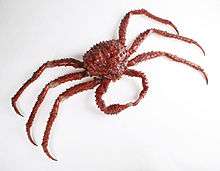Carcinisation
Carcinisation (or carcinization) is an example of convergent evolution in which a crustacean evolves into a crab-like form from a non-crab-like form. The term was introduced into evolutionary biology by L. A. Borradaile, who described it as "one of the many attempts of Nature to evolve a crab".[1]
.jpg)
Examples
Carcinisation is believed to have occurred independently in at least five groups of decapod crustaceans,[2] most notably king crabs,[3][4] which most scientists believe evolved from hermit crab ancestors. The other examples are the family Porcellanidae or porcelain crabs (which are closely related to squat lobsters),[5] the hairy stone crab Lomis hirta,[6] the coconut crab Birgus latro, and true crabs (Brachyura).[7]
King crabs

The example of king crabs (family Lithodidae) evolving from hermit crabs has been particularly well studied, and evidence in their biology supports this theory. For example, most hermit crabs are asymmetrical, so that they fit well into spiral snail shells; the abdomens of king crabs, even though they do not use snail shells for shelter, are also asymmetrical.[8][9][10][11]
Hypercarcinisation
An exceptional form of carcinisation, termed "hypercarcinisation", is seen in the porcelain crab Allopetrolisthes spinifrons.[12] In addition to the shortened body form, A. spinifrons also shows similar sexual dimorphism to that seen in true crabs, where males have a shorter pleon than females.[12]
References
- Patsy A. McLaughlin; Rafael Lemaitre (1997). "Carcinization in the anomura – fact or fiction? I. Evidence from adult morphology". Contributions to Zoology. 67 (2): 79–123. doi:10.1163/18759866-06702001. PDF
- Jonas Keiler; Christian S. Wirkner; Stefan Richter (2017). "One hundred years of carcinization – the evolution of the crab-like habitus in Anomura (Arthropoda: Crustacea)". Biological Journal of the Linnean Society. 121: 200–222. doi:10.1093/biolinnean/blw031.
- Jonas Keiler; Stefan Richter; Christian S. Wirkner (2013). "Evolutionary morphology of the hemolymph vascular system in hermit and king crabs (Crustacea: Decapoda: Anomala)". Journal of Morphology. 274 (7): 759–778. doi:10.1002/jmor.20133. PMID 23508935.
- Jonas Keiler; Stefan Richter; Christian S. Wirkner (2015). "The anatomy of the king crab Hapalogaster mertensii Brandt, 1850 (Anomura: Paguroidea: Hapalogastridae) – new insights into the evolutionary transformation of hermit crabs into king crabs". Contributions to Zoology. 84 (2): 149–165. doi:10.1163/18759866-08402004. Archived from the original on 2017-12-10. Retrieved 2016-11-17.
- Jonas Keiler; Stefan Richter; Christian S. Wirkner (2014). "Evolutionary morphology of the organ systems in squat lobsters and porcelain crabs (Crustacea: Decapoda: Anomala): an insight into carcinization". Journal of Morphology. 276 (1): 1–21. doi:10.1002/jmor.20311. PMID 25156549.
- Jonas Keiler; Stefan Richter; Christian S. Wirkner (2016). "Revealing their innermost secrets: an evolutionary perspective on the disparity of the organ systems in anomuran crabs (Crustacea: Decapoda: Anomura)". Contributions to Zoology. 85 (4): 361–386. doi:10.1163/18759866-08504001.
- C. L. Morrison; A. W. Harvey; S. Lavery; K. Tieu; Y. Huang; C. W. Cunningham (2001). "Mitochondrial gene rearrangements confirm the parallel evolution of the crab-like form" (PDF). Proceedings of the Royal Society B: Biological Sciences. 269 (1489): 345–350. doi:10.1098/rspb.2001.1886. PMC 1690904. PMID 11886621.
- C. W. Cunningham; N. W. Blackstone; L. W. Buss (1992). "Evolution of king crabs from hermit crab ancestors". Nature. 355 (6360): 539–542. Bibcode:1992Natur.355..539C. doi:10.1038/355539a0. PMID 1741031. S2CID 4257029.
- Patsy A. McLaughlin; Rafael Lemaitre; Christopher C. Tudge (2004). "Carcinization in the Anomura – fact or fiction? II. Evidence from larval, megalopal and early juvenile morphology". Contributions to Zoology. 73 (3): 165–205. doi:10.1163/18759866-07303001.
- Ling Ming Tsang; Tin-Yam Chan; Shane T. Ahyong; Ka Hou Chu (2011). "Hermit to king, or hermit to all: multiple transitions to crab-like forms from hermit crab ancestors". Systematic Biology. 60 (5): 616–629. doi:10.1093/sysbio/syr063. PMID 21835822.
- Rafael Lemaitre; Patsy A. McLaughlin (2009). "Recent advances and conflicts in concepts of anomuran phylogeny (Crustacea: Malacostraca)" (PDF). Arthropod Systematics & Phylogeny. 67 (2): 119–135. Archived from the original (PDF) on 2016-08-03. Retrieved 2011-11-19.
- Alexandra Hiller; Carlos Antonio Viviana; Bernd Werding (2010). "Hypercarcinisation: an evolutionary novelty in the commensal porcellanid Allopetrolisthes spinifrons (Crustacea: Decapoda: Porcellanidae)" (PDF). Nauplius. 18 (1): 95–102. Archived from the original (PDF) on 2012-04-25.
| Look up carcinization in Wiktionary, the free dictionary. |